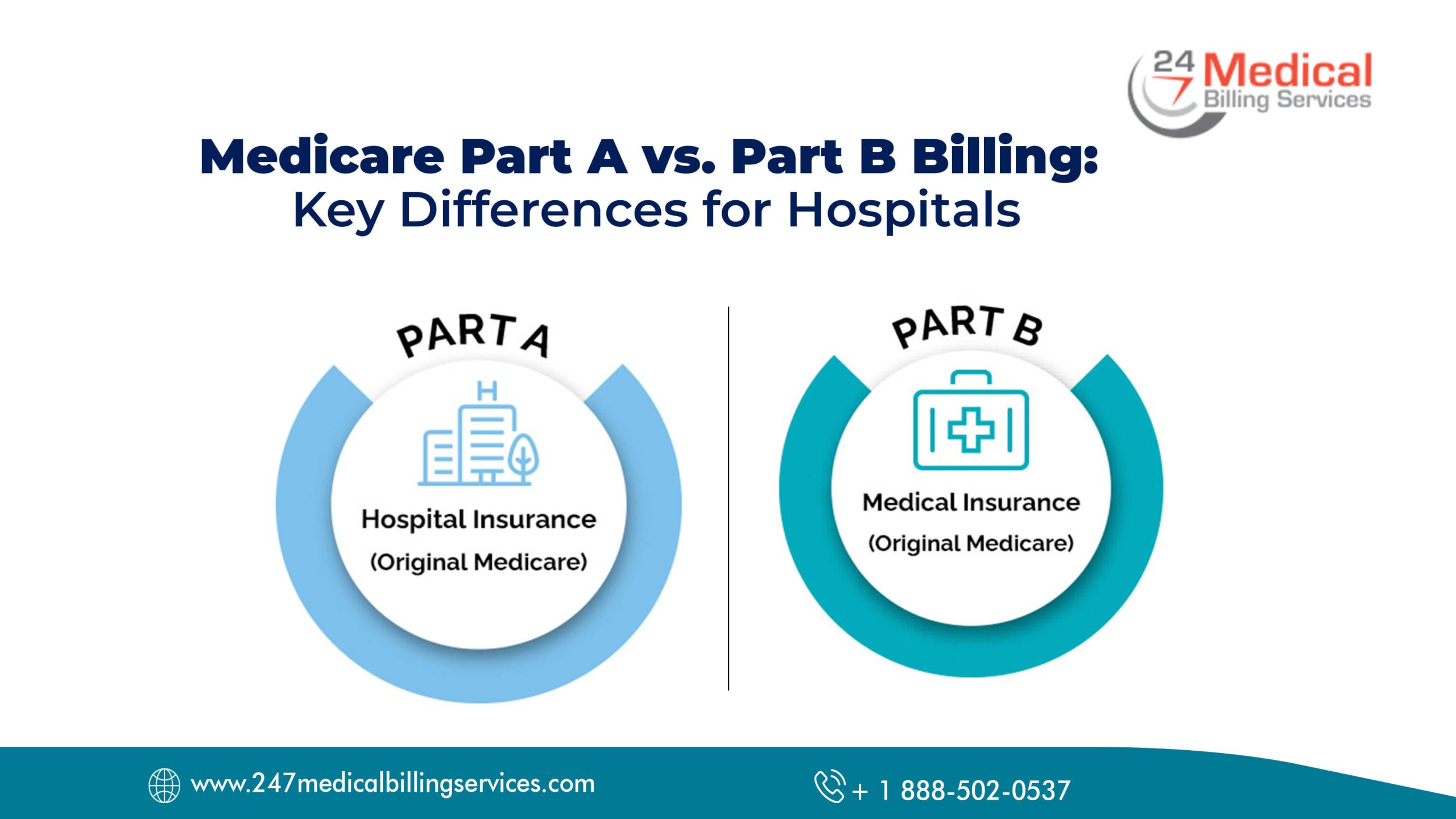
Medicare Part A vs. Part B Billing: Key Differences for Hospitals
Medicare is a government-funded healthcare program for anyone over the age of 65. It is also available to younger persons with specific medical issues or challenges. In fact, each component of Medicare is intended to assist in the payment of various components of healthcare. Understanding the key differences between Medicare Part A and Part B billing is crucial for seniors.
Keeping this in mind, the government separates coverage into sections labeled A, B, C, and D. Part A covers several inpatient care costs. Part B primarily assists in covering outpatient treatment and preventive care costs, such as doctor visits, medical equipment, and some medicines. The out-of-pocket expenditures for the two splits vary, including deductibles and coinsurance.
This blog will explain the fundamental distinctions between Medicare Parts A and B.
MEDICARE PART A
Medicare Part A covers a variety of healthcare aspects, which may include the following:- Short-Term Skilled Nursing Facility Care
- Hospital Care
- Limited Home Healthcare
- Inpatient Care at a Hospital
Eligibility:
To be eligible for Medicare Part A, you must meet one of the following criteria:- be 65 or older,
- have a doctor-determined disability and have received Social Security benefits for at least 24 months,
- have end-stage renal disease.
- have Lou Gehrig's disease, commonly known as amyotrophic lateral sclerosis (ALS).
Costs:
The majority of people who qualify for Medicare do not have to pay for Part A. This is true if you or your spouse paid Medicare taxes for at least 40 quarters (about ten years). Even if you did not work for 40 quarters, you might still pay a monthly Medicare Part A cost.Premium:
Aside from the premium costs (which are sometimes nothing for many individuals), there are other fees like deductible (what you must spend before Medicare pays) and coinsurance (you pay a portion, and Medicare covers a portion). These costs for 2022 are as follows:| Quarters Worked and Paid Medicare Taxes | Premium ($) |
| 40 and more | 0 |
| 30–39 | 274 |
| Less than 30 | 499 |
Hospitalization Costs:
Days 91 and up at a hospital are termed lifetime reserve days. You are given 60 lifetime reserve days to use throughout your life. If you exceed these days, you are responsible for any fees after day 91. A benefit period begins when you are admitted to the hospital and ends when you have not received inpatient care for 60 consecutive days.Here are the Part A hospitalization coinsurance costs for 2022:
| Time Period | Cost ($) |
| Inpatient Days 1 - 60 | 0 |
| Inpatient Days 61 - 90 | 389/ day |
| Inpatient Days 91+ | 778/ day |
| Deductible For Each Benefit Period | 1,566 |
MEDICARE PART B
Some individuals refer to it as "medical insurance." Part B of Medicare covers:- Doctor's Visits,
- Outpatient Therapy,
- Durable Medical Equipment, And
- Prescription Drugs in Some Situations.
Eligibility:
You must be:- 65 or older and
- A US citizen to be eligible for Medicare Part B.
Costs & Premium:
Part B costs vary depending on when you signed up for Medicare and your income level. If you joined Medicare during the open enrollment period and your income did not exceed $91,000 in 2020, your Medicare Part B premium in 2022 will be $170.10. However, if you earn $500,000 or more as an individual or more than $750,000 as a couple filing jointly, your Part B premium in 2022 will be $578.30 per month.If you receive benefits from Social Security, the Railroad Retirement Board, or the Office of Personnel Management, the Medicare deductible will be deducted before your benefits are sent to you. In 2022, the annual deductible is $233. If you do not enroll in Medicare Part B during your enrollment period (typically around the time you reach 65), you may have to pay a monthly late enrollment penalty.
Once you have met your Medicare Part B deductible, you will typically pay 20% of the Medicare-approved service cost, with Medicare covering the remaining 80%.
Enrollment Periods for Medicare Part A & Part B Billing:
Don't miss these critical deadlines if you will be enrolling in Medicare soon (or passing on plans):Initial enrollment period: The initial enrollment period is three months before your 65th birthday, your birthday month, and three months following your 65th birthday.
General enrollment: The general enrollment for Medicare Part B is from January 1 to March 31 if you did not sign up during your first enrollment period.
Open enrollment: The open enrollment period for Medicare Advantage and Part D drug plans is from October 15 through December 7.
Takeaway- Medicare Part A vs. Part B Billing
Undoubtedly, Parts A and B of Medicare cover different sorts of health services. Part A generally covers inpatient treatments, while Part B covers doctor visits, some medical supplies, and some DME. If a person has paid Billing for Medicare taxes through employment for at least ten years, they are eligible for premium-free Part A. On the other hand, Part B has a premium determined by an individual's income. There is a lot to be aware of to enjoy the complete benefit. The most optimal solution is to contact the 24/7 Medical Billing Services team for accurate and professional guidance.See also: Maximizing Reimbursement Under Medicare Physician Payment

.png)